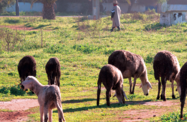Morocco: Boosting agriculture
 En Français
En Français
Already boasting an incredibly close bilateral relationship, export volumes between the EU and Morocco look to grow even further as continuing liberalisation – in the guise of a pair of new trade agreements – loosens restrictions on agricultural and seafood products.
In February, after much heated debate, the European parliament narrowly approved measures to liberalise trade with Morocco in agricultural and fisheries products. The new legislation allows for an increase in specific quotas, currently worth an estimated €100m per year, for zero- or low-duty imports. It also will immediately cut 55% of tariffs on Moroccan agricultural and fisheries products and 70% of tariffs on similar EU products for a period of 10 years. In total, 45% of all EU imports to Morocco will become duty-free.
Some of the main EU products to have their import duties eliminated include poultry, butter, certain cheeses, fruit, UHT milk, olive oil, tomatoes, durum wheat products, fruit and vegetable juices, nuts, potatoes and tobacco. Moroccan products to be included in the duty-free category are tomatoes, garlic, courgettes, cucumber, artichokes, apricots, grapes, peaches, oranges and chemically pure fructose.
Proponents of the deal, which builds on an existing agricultural agreement from 2008, say that it will likely create better investment opportunities for EU companies and more jobs for the Moroccan agricultural sector.
Today, the sector represents 15% of Morocco’s GDP and is a major source of employment, with 3m-4m people working in the agricultural and agro-industrial fields. The total value of agricultural exports totalled €1.4bn in 2010, the majority of which went to the EU.
The measures had to overcome heated criticism in the EU parliament, fuelled by concerns over the subsequent impacts on domestic European production.
Aziz Akhannouch, Morocco’s agriculture and fisheries minister, dismissed these concerns, telling local media in February that both EU companies and Moroccan small farmers affiliated with giant exporting cooperatives would benefit from the deal. He said that 80% of Moroccan farms are less than 5 ha in size and thus unable to export their produce without joining larger cooperatives.
To alleviate such concerns, the bill includes numerous “safeguards”, such as only allowing slight increases for quotas of certain products, specifically tomatoes, strawberries, cucumbers and garlic. The agreement also provides for seasonal quotas to counter oversupply and distortion in the EU market, limiting the impact of granting improved access to unprocessed fruit and vegetables from Morocco, which currently make up 80% of total EU imports. The accord also calls for Moroccan imports to meet European sanitary standards, which in the past have been a barrier to exports.
The EU parliament has also called on the European Commission to monitor strict application of quotas and strengthen controls to avoid possible fraud in the entry price system, while simultaneously requesting an assessment of the impact on European producers and farmers’ incomes. They have also insisted on the inclusion of a “rendezvous clause”, which states that both parties must meet no later than three years from the start of the agreement to consider further alterations and concessions.
The deal comes as part of a long-term effort by the Moroccan government to strengthen the performance and output of the domestic agricultural sector. The country has long held a competitive edge in fruit and vegetable production due to a fortuituous geography, but has suffered from volatile swings in production due to water issues and outdated cultivation and harvesting methods.
The government’s cornerstone initiative for this comprehensive overhaul of the sector is the Plan Vert, a multi-billion euro agricultural development programme. Launched in 2008, Plan Vert aims to increase the sector’s profitability and spur rural development by seeking out private investment in regions with a high agricultural potential through subsidies and improved infrastructure. Plan Vert also provides for the modernisation of farming methods in arid regions and increases environmental protection standards.
The results have indeed been encouraging. Since 2007, fertiliser use has increased by 7%, the mechanisation of farming techniques has risen by 27%, and the use of irrigation systems has gone up by 127%.
Should these initiatives lead to increased production as expected, the new yields will soon have a new home in the EU market.



